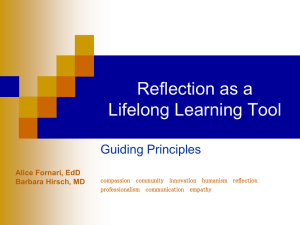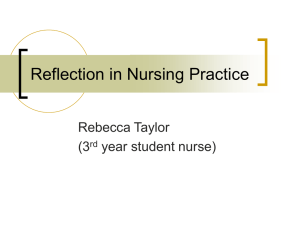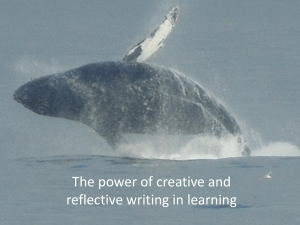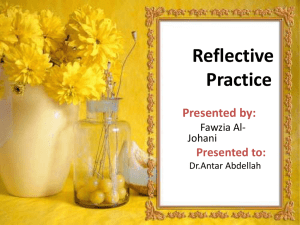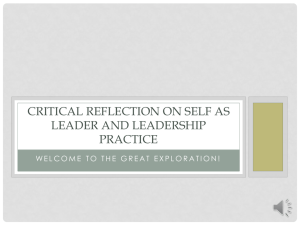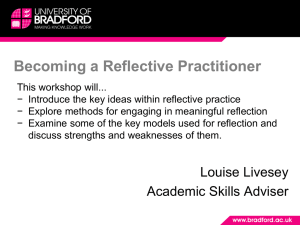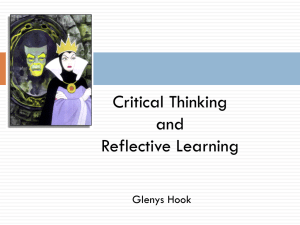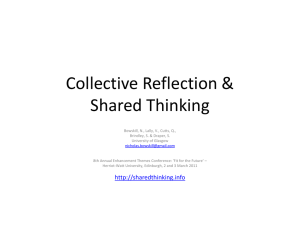Using Action Research to Advance Planning and
advertisement
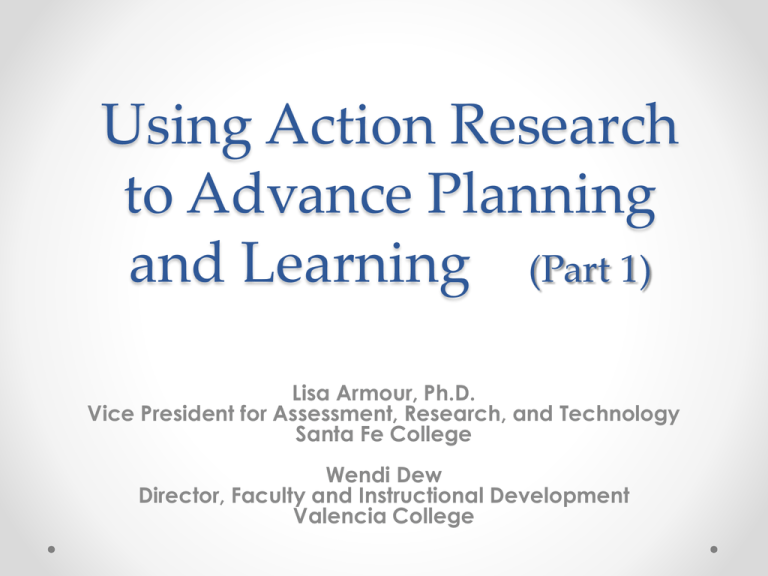
Using Action Research to Advance Planning and Learning (Part 1) Lisa Armour, Ph.D. Vice President for Assessment, Research, and Technology Santa Fe College Wendi Dew Director, Faculty and Instructional Development Valencia College Today’s Learning Outcomes • Identify the elements of action research • Give examples of action research frames as means for inspiring professional development for faculty • Relate action research frames to iterative cycles of improvement within a department or division • Discuss action research as a tool for meeting department planning and learning goals • Identify resources available to faculty conducting action research projects Action research attempts to provide some insight into how students learn. It encourages teachers, counselors and librarians to use their classrooms, offices and libraries as laboratories for the study of learning. Tom Angelo Action Research supports data-informed decision-making by faculty. • The purpose of action research is to make decisions • Research questions derive from individual practice • Theory plays a secondary role (Mc Millan, J. H. & Wergin. J. F., Understanding and Evaluating Educational Research) Action Research is • A deliberate, solution-oriented investigation • Characterized by spiraling cycles of • problem identification • systematic data collection • analysis • reflection • data-driven action • problem redefinition (Kemmis & McTaggart, The Action Research Planner) Plan Plan Reflect Plan Reflect Act Observe Act Observe Reflect Act Observe “Ways in” to the Scholarship of Teaching and Learning (SoTL) • Examine unexplained student successes, in order to replicate or build on them • Focus on critical and challenging teaching goals and/or student learning outcomes • Apply general, research-based principles for good practice in teaching and learning to our specific practice • Examine a hunch (developed through observation and practice) about what is likely to work • Focus on a common problem or an issue that seems to recur Tom Angelo Which action research frames (or “ways in” to SoTL) could you emphasize to inspire professional development in your department? Action Research supports improved individual practice, and serves as an incubator for institutional innovations. • Applied research develops faculty as informed change agents, focused on improving student learning through reflective teaching • Faculty insights, based on direct observation of students, contribute to innovative institutional practices and programs related to student engagement and learning • Direct evidence of student learning informs institutional strategy Elements of an Action Research Project Clear Goals (Abstract and Research Question) Adequate Preparation Appropriate Methods Significant Results Reflective Critique Effective Presentation Writing an Effective Research Question • • • • • • • • Does it address a persistent problem or area of concern in the class/professional setting? Is it specific, significant, and related to improving student learning? Can the goal or standard for students’ achievements be clearly stated? What kind of evidence can be produced to show the situation as it is? Is it within the faculty member’s power to address the question (teaching strategies, classroom activities, student assignments)? Is it feasible in terms of time, effort and available resources? Can action be taken based on the results? Is this an area where the faculty member is willing to make a change? Do you have experience with research questions embedded in Faculty Learning Outcomes associated with action research? If so, do they typically exhibit the qualities of an effective research question? How can you inspire faculty to pursue research that assists you in meeting department learning goals? How can you coach faculty to ensure the research questions they pose are feasible in terms of time, effort, and available resources? Elements of an Action Research Project Clear Goals Adequate Preparation (Perspectives) Appropriate Methods Significant Results Reflective Critique Effective Presentation Action Research supports reflective or scholarly teaching. • Finding answers to educational problems is a complex undertaking. Whether awareness of the problem arises as a result of classroom observation, the reading of learned journals or armchair theorising, there is always a range of perspectives that can be brought to bear on a problem. Mary Ainley and Sarah Buckley Perspectives to Consider • Look at the work from multiple perspectives o Student o Colleague o Expert o Self What do • interaction with students • interaction with colleagues • the literature • your personal experience tell you about topics of importance in your department or discipline? Elements of an Action Research Project Clear Goals Adequate Preparation Appropriate Methods (Methods and Assessment) Significant Results Reflective Critique Effective Presentation Student Learning Outcomes, Performance Indicators, and Assessments • • • • Are the Student Learning Outcomes observable, measurable, and consistent with shared expectations (e.g. Course Outlines) Do identified Performance Indicators provide convincing evidence of student learning? Will the chosen assessments provide direct evidence of mastery of the Student Learning Outcomes? Validity is the extent to which an assessment measures what it is supposed to measure. Teaching Strategies, Action Research and Methodology Design • For an action research project, consider these questions: • • What teaching strategies are appropriate for achieving the Student Learning Outcomes? What data would convince other professionals (particularly faculty members in the discipline) of the level of student mastery of the Student Learning Outcomes? How can the project be organized and described so that it will serve as a catalyst for improvement as well as a blueprint? Focus on one or two valid measures of the project’s impact. Reliability is the extent to which an experiment is repeatable and yields consistent results. Please join us after the break for Part 2! Using Action Research to Advance Planning and Learning (Part 2) Lisa Armour, Ph.D. Vice President for Assessment, Research, and Technology Santa Fe College Wendi Dew Director, Faculty and Instructional Development Valencia College What are the student learning outcomes central to student success in your department or discipline? What are some related performance indicators and assessment measures? Would these assessment measures be considered convincing by most faculty in your discipline? How can you promote the use of assessment measures considered convincing by most faculty in your discipline within individual action research projects? Elements of an Action Research Project Clear Goals Adequate Preparation Appropriate Methods Significant Results (Project Results) Reflective Critique Effective Presentation Action Research makes a difference! A. Are results described clearly and completely? B. Did the students achieve the Student Learning Outcomes? C. What if they did not achieve the SLOs? Interpretation of Results • Cause and Effect vs. Correlation o Action research may reveal correlation between variables, but often it will not establish a cause and effect relationship. o Controlled experiments are needed to convince sophisticated readers of a cause and effect relationship between variables. o Faculty may choose to make cases for cause and effect based on their professional judgment. If they do, they should explain the factors informing their judgment. Explanations • When correlation is claimed, explanations other than cause/effect (confounding variables) should be considered and explained. • What perceived impact did the project have in terms of changes in knowledge, abilities, attitudes, values and commitment of students or faculty? • Were the results as expected? How can we use action research to make learning more meaningful to students? Elements of an Action Research Project Clear Goals Adequate Preparation Appropriate Methods Significant Results Reflective Critique (General Reflection, Essential Competencies) Effective Presentation Action research includes reflection about what has happened, as well as reflection about what should happen next. In a reflective critique, faculty • Analyze the project • Apply professional judgment • Share insights • Describe plans for improvement • Express personal observations in a professional manner Elements of an Action Research Project Clear Goals Adequate Preparation Appropriate Methods Significant Results Reflective Critique Effective Presentation Effective Presentation Spelling, grammar, and style are important Pay attention to language and tone Charts and graphs should be used when possible “Accessible” (audience-appropriate) statistics should be provided • Measures of central tendency and measures of variation should be included when quantitative data are described. • Valencia’s Action Research Builder provides structure • • • • Learning-centered Planning and Assessment • Learning-centered questions are the essential foundation for strategic planning and learning-centered program assessment • Key Questions o “Ways In” to an iterative cycle of improvement • What do we want to change or improve about student learning, development and/or the student experience? • How will this impact student learning? • How will we know? Planning Essentials: A Cascading Mission Cascading Mission, Goals and Outcomes Meaningful connection to institutional planning across all units Critical alignment to the mission and goals Meaningful assessment and improvement “down and in” Creates opportunities for unit-to-unit collaboration Strategic Plan Institution (Mission, Vision Goals, Outcomes) Program, Discipline, Division or Unit Planning Annual Faculty and Staff Planning/ Development Individual - Kurt Ewen, Valencia College Planning Essentials: Collaborative, Inter-related Reflection and Planning Cycles Strategic Plan Mission, Vision Goals, Outcomes Use data to make decisions to improve over time Program, Discipline, Division or Unit Planning Annual Faculty and Staff Planning/ Assessment Measures and Criteria for Success Development Document and analyze evidence - Kurt Ewen, Valencia College Some “ways in” to the Scholarship of Teaching and Learning (slide 8) for individual faculty are o Focus on critical and challenging teaching goals and/or student learning outcomes o Focus on a common problem or an issue that seems to recur How can you partner with faculty conducting action research so their “ways in “ to SoTL have the additional benefit of serving as department or division “ways in” to an iterative cycle of improvement? Planning and Learning Outcomes to Assessment • Planning Objectives/Outcomes are brief, clear statements that describe the desired outcomes of the organization, division, or unit o Division Action Plan (academic units) o Department Action Plan (non-academic units, Student Affairs) o May or may not be learning outcomes • Learning Objectives/Outcomes are clear statements that describe the desired learning result o What students should be able to know or do at the end of a program, course or co-curricular experience (specific skills, values, and attitudes) o Curricular and co-curricular learning outcomes How will you ensure alignment of your planning goals and outcomes, as well as the college’s learning goals and outcomes with o o The Faculty Learning Outcomes associated with individual projects (specifically action research projects) Student Learning Outcomes associated with individual faculty projects What resources are available to faculty conducting action research projects? What resources are available to deans sponsoring action research projects? Thanks for participating!




